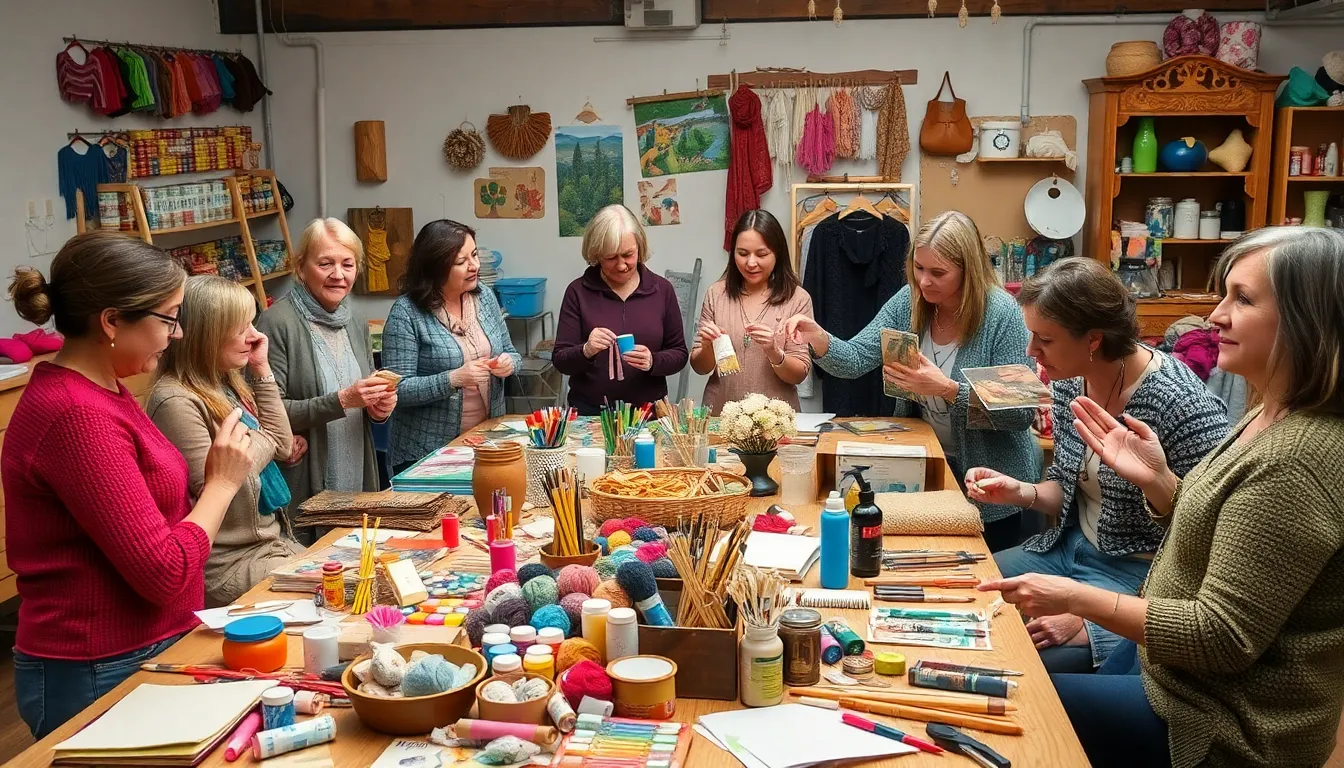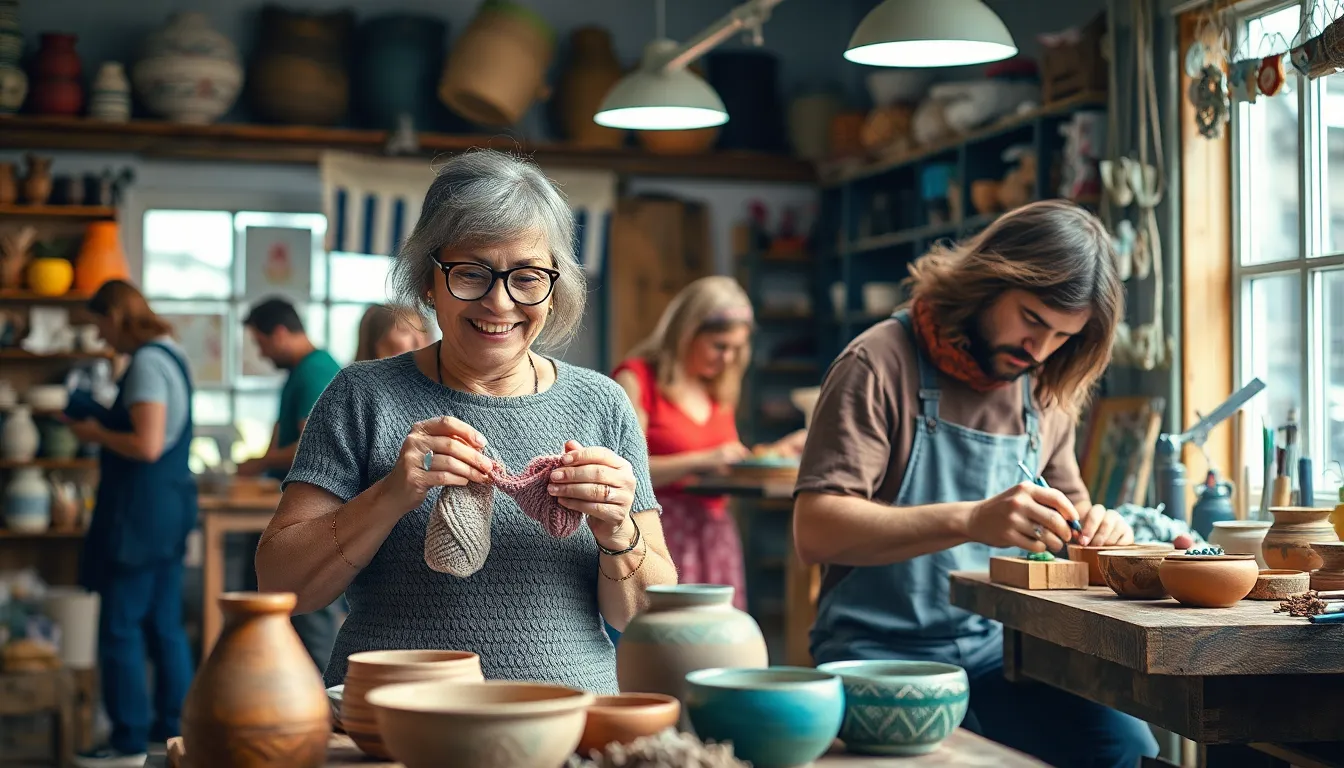In a world increasingly driven by technology, the craft community stands as a vibrant testament to creativity and connection. This diverse group of artisans, hobbyists, and makers fosters a unique culture that celebrates handmade goods, skill sharing, and personal expression. From knitting circles to pottery studios, these communities thrive on collaboration and support, encouraging individuals to explore their talents and passions.
Crafting isn’t just about creating; it’s about building relationships and finding a sense of belonging. As more people seek fulfillment beyond the digital realm, the craft community offers a welcoming space for learning, inspiration, and friendship. Whether someone is a seasoned expert or just starting out, the joy of crafting brings people together in meaningful ways, making it a powerful force in today’s society.
Table of Contents
ToggleOverview of Craft Community
The craft community thrives on creativity, connection, and collaboration. It brings together artisans, hobbyists, and makers, creating an environment rich in diversity and skill. Participants engage in various crafts, such as knitting, woodworking, pottery, and more, enhancing personal expression and fostering innovation.
Members share techniques, tools, and ideas, driving personal growth and collective enrichment. Local craft fairs, workshops, and online platforms facilitate collaboration and knowledge exchange. This active participation cultivates a sense of belonging and support among individuals from varying backgrounds and expertise levels.
The digital age has expanded the reach of the craft community, allowing global interaction. Online groups and social media platforms provide a space for sharing tutorials, inspiration, and finished projects. This accessibility encourages more people to explore crafts, turning occasional hobbyists into passionate contributors.
Through these interactions, the community emphasizes the importance of patience, practice, and perseverance. As individuals navigate their crafting journeys, they form lasting friendships and partnerships that extend beyond the workspace. The craft community, therefore, not only nurtures talent but also enriches social ties, creating a vibrant network of creators.
Importance of Craft Community

The craft community plays a crucial role in nurturing relationships and enhancing personal skills. Its impact extends beyond crafting techniques, as it fosters meaningful social connections and facilitates skill development among members.
Social Connections
Social connections thrive in the craft community through shared interests and collaborative projects. Individuals participate in local events, workshops, and online forums, creating bonds with others who share similar passions. These interactions encourage communication and provide support networks, contributing to improved mental well-being. Members often exchange ideas, tips, and encouragement, reinforcing friendships and building a sense of belonging. Social connections within the craft community also extend beyond crafting, as members engage in various community activities, making the experience enriching on multiple levels.
Skill Development
Skill development emerges as a foundational element within the craft community. Members at all levels benefit from the exchange of techniques and knowledge. Beginners gain confidence through mentorship from experienced crafters, while seasoned artisans refine their skills through collaboration. Workshops and classes often focus on specific crafts, allowing participants to hone their abilities and explore new artistic avenues. The community encourages continuous learning, emphasizing practice and experimentation. This collective approach not only enhances individual skills but also elevates the overall quality of craftsmanship across the community.
Types of Craft Communities
Craft communities manifest in various forms, bringing together individuals of all skill levels through shared interests and passions. Two primary types of craft communities arise: online craft communities and local craft groups.
Online Craft Communities
Online craft communities provide platforms for artisans and hobbyists to connect globally. Websites, forums, and social media groups offer spaces for sharing projects, techniques, and inspiration. Popular sites like Ravelry for knitting and crafting and Pinterest for visual ideas help members showcase their work and discover new techniques. Members can participate in discussions, ask questions, and receive feedback from a diverse audience. Virtual challenges and collaborations foster camaraderie, allowing for the exchange of ideas regardless of geographical location. Additionally, many online communities host live classes and tutorials, improving members’ skills and widening their craft knowledge.
Local Craft Groups
Local craft groups focus on in-person interactions among community members. These groups often form through local crafting stores, libraries, or community centers, hosting regular meetings, workshops, and events. Members can learn new skills, share resources, and collaborate on projects directly. Local craft fairs and markets offer additional opportunities for showcasing creations, selling crafts, and building personal networks. Events like “Knit Nights” or pottery workshops create an inviting atmosphere where participants build genuine relationships. Through these face-to-face connections, individuals develop a stronger sense of belonging and support, enhancing the overall crafting experience.
Craft Community Events
Craft community events play a vital role in enhancing connections and facilitating skill development among members. Various activities cater to individuals at all levels, ranging from workshops and classes to craft fairs and exhibitions.
Workshops and Classes
Workshops and classes serve as essential platforms for skill enhancement and knowledge exchange. They allow participants to learn new techniques and refine existing skills under the guidance of experienced artisans. Workshops often cover a range of topics, such as knitting, woodworking, or pottery, and vary in duration from a few hours to several weeks. Many artisans also offer specialized classes that focus on unique techniques, such as dyeing fabrics or creating intricate designs. These events foster a collaborative environment where community members share their experiences and support each other’s creative journeys, strengthening bonds while enriching individual craftsmanship.
Craft Fairs and Exhibitions
Craft fairs and exhibitions provide opportunities for artisans to showcase their work and network with fellow crafting enthusiasts. These events typically feature booths or tables displaying handmade items, ranging from textiles to furniture. Artisans can connect with potential customers, gaining valuable exposure and feedback on their creations. Furthermore, craft fairs often include demonstrations, allowing attendees to observe techniques in action and engage with the artists behind the work. This interaction emphasizes the community aspect, as participants celebrate shared passions and discover new inspiration for their craft. Overall, craft fairs and exhibitions contribute significantly to the vibrancy of the craft community, fostering relationships and encouraging creativity.
Challenges in Craft Community
Despite its positive aspects, the craft community faces several challenges that impact its growth and inclusivity. Members encounter issues related to inclusivity and sustainability that need addressing for the community to thrive.
Inclusivity Issues
Inclusivity represents a significant challenge within the craft community. Many individuals from marginalized groups encounter barriers that prevent full participation. Factors such as socioeconomic status, access to materials, and cultural differences create disparities in participation levels. Specific instances include underrepresentation of indigenous artisans, women artisans, and individuals with disabilities in discussions and events. Community leaders can address these issues by actively promoting diversity initiatives, offering scholarships for workshops, and creating safe spaces where all voices are heard. By fostering a culture of inclusivity, the craft community can ensure varied perspectives enrich its fabric, allowing everyone to contribute.
Sustainability Concerns
Sustainability poses another pressing challenge in the craft community. As crafting often involves the use of natural resources, environmentally harmful practices can compromise the community’s longevity. Specific concerns include the overuse of materials, reliance on plastic and synthetic supplies, and waste generated from unsold products. Artisans can mitigate these effects by adopting eco-friendly practices, such as sourcing sustainable materials, repurposing items, and minimizing packaging. Community support for local suppliers can promote sustainable practices and awareness. Education around sustainable crafting techniques, such as hand-dyeing and zero-waste methods, can empower artisans to create responsibly while reducing environmental impact. Addressing sustainability ensures the craft community can flourish while preserving resources for future generations.
The craft community stands as a beacon of creativity and connection in today’s fast-paced world. It nurtures relationships that transcend mere crafting, offering individuals a sense of belonging and support. By embracing diversity and promoting inclusivity, the community can continue to flourish, welcoming new members from all backgrounds.
As artisans and hobbyists come together, they not only enhance their skills but also enrich each other’s lives. The shared experiences and collaborative spirit foster a vibrant network that thrives on creativity. With a commitment to sustainability and eco-friendly practices, the craft community can ensure its legacy for future generations, making crafting a fulfilling and responsible pursuit.







